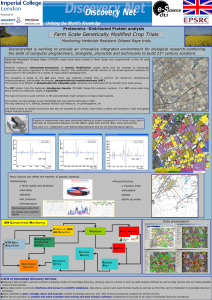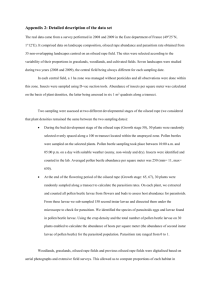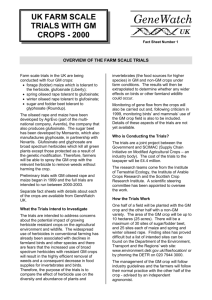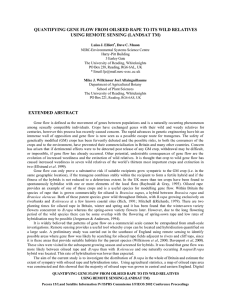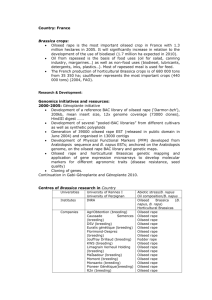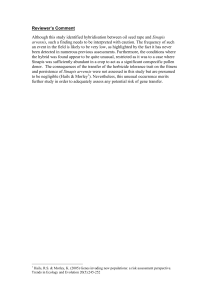THE FARM SCALE TRIALS WITH GENETICALLY
advertisement
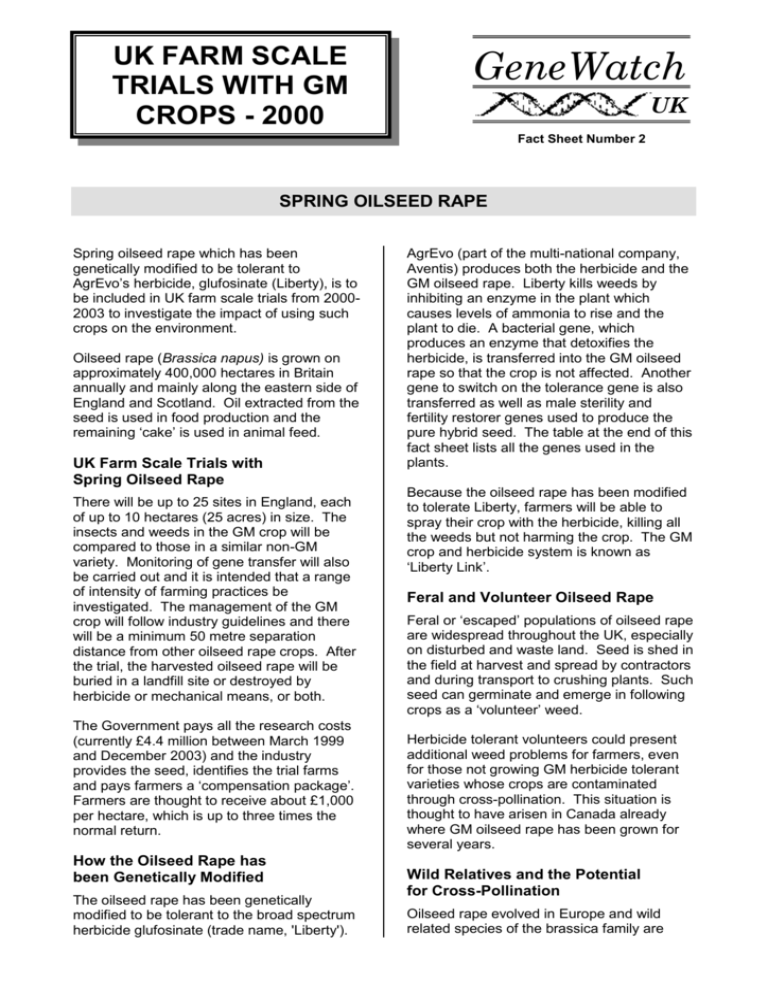
UK FARM SCALE TRIALS WITH GM CROPS - 2000 GeneWatch UK Fact Sheet Number 2 SPRING OILSEED RAPE Spring oilseed rape which has been genetically modified to be tolerant to AgrEvo’s herbicide, glufosinate (Liberty), is to be included in UK farm scale trials from 20002003 to investigate the impact of using such crops on the environment. Oilseed rape (Brassica napus) is grown on approximately 400,000 hectares in Britain annually and mainly along the eastern side of England and Scotland. Oil extracted from the seed is used in food production and the remaining ‘cake’ is used in animal feed. UK Farm Scale Trials with Spring Oilseed Rape There will be up to 25 sites in England, each of up to 10 hectares (25 acres) in size. The insects and weeds in the GM crop will be compared to those in a similar non-GM variety. Monitoring of gene transfer will also be carried out and it is intended that a range of intensity of farming practices be investigated. The management of the GM crop will follow industry guidelines and there will be a minimum 50 metre separation distance from other oilseed rape crops. After the trial, the harvested oilseed rape will be buried in a landfill site or destroyed by herbicide or mechanical means, or both. The Government pays all the research costs (currently £4.4 million between March 1999 and December 2003) and the industry provides the seed, identifies the trial farms and pays farmers a ‘compensation package’. Farmers are thought to receive about £1,000 per hectare, which is up to three times the normal return. How the Oilseed Rape has been Genetically Modified The oilseed rape has been genetically modified to be tolerant to the broad spectrum herbicide glufosinate (trade name, 'Liberty'). AgrEvo (part of the multi-national company, Aventis) produces both the herbicide and the GM oilseed rape. Liberty kills weeds by inhibiting an enzyme in the plant which causes levels of ammonia to rise and the plant to die. A bacterial gene, which produces an enzyme that detoxifies the herbicide, is transferred into the GM oilseed rape so that the crop is not affected. Another gene to switch on the tolerance gene is also transferred as well as male sterility and fertility restorer genes used to produce the pure hybrid seed. The table at the end of this fact sheet lists all the genes used in the plants. Because the oilseed rape has been modified to tolerate Liberty, farmers will be able to spray their crop with the herbicide, killing all the weeds but not harming the crop. The GM crop and herbicide system is known as ‘Liberty Link’. Feral and Volunteer Oilseed Rape Feral or ‘escaped’ populations of oilseed rape are widespread throughout the UK, especially on disturbed and waste land. Seed is shed in the field at harvest and spread by contractors and during transport to crushing plants. Such seed can germinate and emerge in following crops as a ‘volunteer’ weed. Herbicide tolerant volunteers could present additional weed problems for farmers, even for those not growing GM herbicide tolerant varieties whose crops are contaminated through cross-pollination. This situation is thought to have arisen in Canada already where GM oilseed rape has been grown for several years. Wild Relatives and the Potential for Cross-Pollination Oilseed rape evolved in Europe and wild related species of the brassica family are found near to existing rape fields. It is both wind and insect pollinated and pollen from oilseed rape can travel at least 4km and successfully pollinate other oilseed rape plants. Because oilseed rape is widely used by honey bees, pollen will also be found in the honey. Oilseed rape can cross with wild radish, wild turnip, hoary mustard, and mustard greens. In the long term, gene flow to related wild plants is inevitable. Although no comprehensive research has been undertaken, some scientists argue that transfer of the herbicide tolerance gene to wild relatives is not important as it will not give a competitive advantage except in the presence of herbicide and that other herbicides can be used to destroy weeds should they emerge. Herbicide Safety AgrEvo claims that glufosinate is ‘environmentally friendly’ as it is less toxic than some other herbicides. However, glufosinate is not only toxic to plants and aquatic life, but can also affect humans. Symptoms of glufosinate poisoning in humans include convulsions and short-term memory loss and studies have shown that it can cause deformities in rat and mouse embryo cultures. The increased use of this chemical may therefore pose health risks for farm workers. Glufosinate also kills many soil bacteria and fungi so may affect soil microflora. Concerns about the Trials The farm scale trials are being presented by Government and the industry as addressing all the outstanding issues. However: The trials are short term and will not be able to identify long-term, cumulative environmental impacts. How cross-contamination of neighbouring conventional and organic crops will be handled in the long term is unclear. Studies of soil microflora are not included in the trials. As yet, there are no regulations addressing the safety of feeding GM crops to animals. Oil from GM oilseed rape would not be labelled under current regulations. There is no legal liability for any environmental harm caused by releases of GM crops. The taxpayer is financing safety testing which should be funded by the industry. There is no process of local or national public consultation. The genes transferred into spring oilseed rape Gene Function PssuAra – promoter gene from thale cress, Arabidopsis thaliana Switches on the herbicide tolerance bar gene. bar – the glufosinate tolerance gene from Streptomyces hygroscopicus Makes the plant tolerant to the herbicide glufosinate. 3’g7 and 3’nos – from the bacterial vector Agrobacterium tumifaciens Remnant genetic material from the vector used to transfer the genes. PTA29 – promoter gene from the tobacco plant Nicotiana tabacum Directs the expression of the male sterility gene, barnase, to a layer of the anther so pollen is not produced. Barnase – the male sterility gene from the bacterium Bacillus amyloliquefaciens The hybrid production system used to produce the seed. A male sterile line, where pollen is not produced because of the barstar gene, is crossed with a fertility restorer line which counteracts the male sterility and allows fertile seeds to be produced. Both sets of genes are present in hybrid crops grown by farmers. Barstar - fertility restoration gene from the bacterium B. amyloliquefaciens Inhibits the action of barnase, restoring fertility to the plant. GeneWatch UK, The Mill House, Manchester Road, Tideswell, Buxton, Derbyshire, SK17 8LN Phone: 01298 871898 Fax: 01298 872531 Email: mail@genewatch.org Website: www.genewatch.org Printed and Published by GeneWatch UK – August 2000
